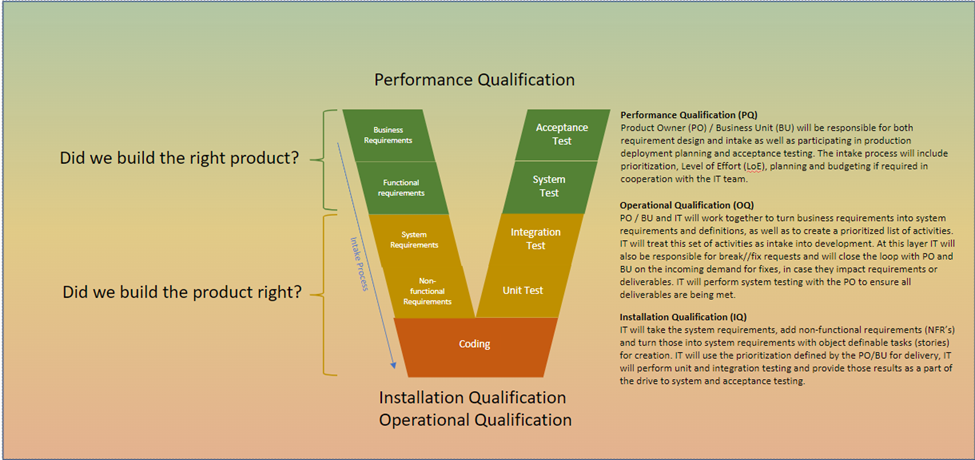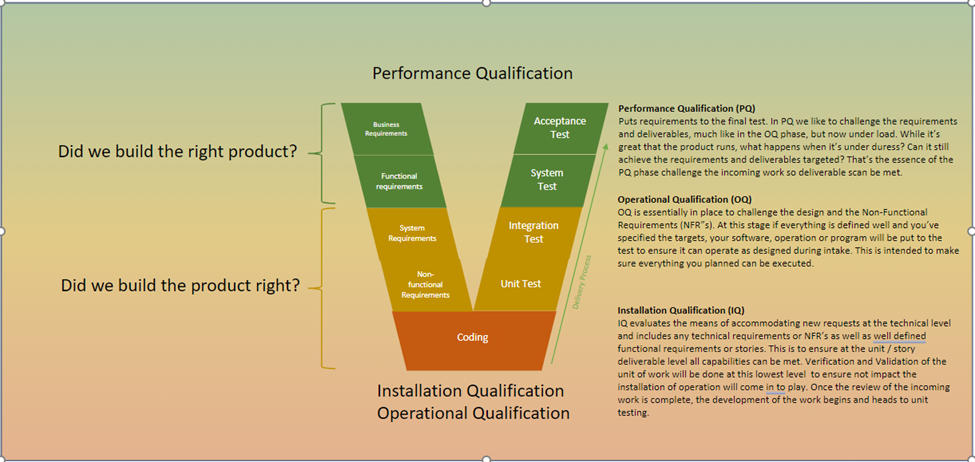In this article, I will be going over how the Validation “V” applies to current DevOps and improves and accelerates the development lifecycle. If you are a fan of war movies you may have heard this quote before “Slow is smooth, smooth is Fast” this is the heart of performing the Validation “V”.
In the fast-paced world of DevOps, delivering high-quality software quickly is paramount. But speed shouldn’t come at the expense of building the wrong product. This is where the concept of validation, often symbolized by “V”, becomes crucial.
Validation in DevOps is a continuous process that ensures software products meet the intended use and requirements. Unlike verification, which checks whether the product is built correctly, validation ensures that the right product is built. It focuses on the end-user experience and the fulfillment of business needs.
High Level pictorial of the V model.


In the realm of development operations (DevOps), the concept of validation plays a crucial role in ensuring that software products meet specified requirements and function correctly. Validation, often symbolized as “V,” encompasses a series of activities designed to ensure that a system or component behaves as intended and meets the needs of its stakeholders. This article delves into the significance of validation “V” in DevOps, its methodologies, and its impact on the software development lifecycle.
Understanding Validation vs. Verification
Validation and verification are two sides of the same quality assurance coin, but they address different aspects:
Verification: Ensures the software is built correctly according to its design and specifications. It’s an internal process, checking if you’re “building it right.”
Validation: Ensures the software meets the actual needs of the users and stakeholders. It focuses on the external perspective, asking “are you building the right thing?”
The “V” in DevOps represents the emphasis on validation throughout the development lifecycle. This is often embodied in the V-model, a development methodology that pairs each development stage with a corresponding validation activity.
Benefits of Early and Continuous Validation
Integrating validation practices throughout DevOps offers several advantages:
Reduced rework: Identifying issues early allows for quicker fixes, minimizing costly rework later in the development cycle.
Improved user satisfaction: By validating against user needs from the beginning, you’re more likely to deliver a product that truly solves their problems.
Enhanced communication: Validation activities often involve user feedback loops, fostering better communication and collaboration between development teams and stakeholders.
Practical Applications of Validation in DevOps
Here’s how validation can be implemented in a DevOps environment:
User acceptance testing (UAT): Involving real users in testing ensures the software aligns with their expectations.
Shift-left testing: Integrating automated tests earlier in the development pipeline allows for continuous validation and feedback.
Performance monitoring: Monitoring key performance indicators (KPIs) throughout development and after deployment helps validate the software’s functionality under real-world conditions.
In greater detail, the “V” model is a framework that highlights the relationship between each phase of the development lifecycle and its corresponding validation phase. It is a variation of the waterfall model and is often depicted in a V-shape, where the left side represents the development activities, and the right side represents the validation activities. Here’s a brief overview of the stages involved:
Requirements Analysis and Validation
Development Side: Gathering and analyzing user and system requirements.
Validation Side: Conducting requirement reviews to ensure completeness and accuracy.
System Design and Validation
Development Side: Designing the overall system architecture.
Validation Side: Performing system design reviews and prototyping to validate the design.
Architectural Design and Validation
Development Side: Creating high-level architectural designs.
Validation Side: Conducting architectural reviews and validating the design against requirements.
Module Design and Validation
Development Side: Detailed design of individual modules.
Validation Side: Reviewing and validating module designs.
Coding and Unit Testing
Development Side: Writing code for each module.
Validation Side: Performing unit tests to validate that each module functions correctly.
Integration and System Testing
Development Side: Integrating modules into a complete system.
Validation Side: Conducting system tests to validate the integrated system’s functionality.
User Acceptance Testing (UAT)
Development Side: Preparing the system for deployment.
Validation Side: Conducting UAT to ensure the system meets user needs and requirements.
Importance of Validation in DevOps
Quality Assurance: Validation ensures that the software product meets quality standards and performs as expected in real-world scenarios.
Risk Mitigation: By validating at each stage of development, potential issues can be identified and addressed early, reducing the risk of costly fixes later.
Customer Satisfaction: Validation focuses on end-user requirements, ensuring that the final product meets user expectations and delivers value.
Regulatory Compliance: In industries with strict regulations, validation is crucial to ensure that the software complies with relevant standards and laws.
Validation Techniques in DevOps
Automated Testing: Implementing automated tests for unit, integration, and system levels to ensure continuous validation throughout the development lifecycle.
Continuous Integration/Continuous Deployment (CI/CD): Integrating validation steps into the CI/CD pipeline to ensure that code changes are continuously validated before deployment.
Peer Reviews: Conducting peer reviews and code inspections to validate code quality and design adherence.
Prototyping: Creating prototypes to validate design concepts and gather early user feedback.
Simulations: Using simulations to validate system behavior under various conditions and workloads.
Conclusion
By embracing validation throughout the DevOps process, you can ensure you’re not just delivering software quickly, but delivering the right software. This focus on validation leads to higher quality products, happier users, and a more successful development cycle.
The Validation “V” is an integral part of DevOps that ensures the development of high-quality software products. By implementing robust validation practices, organizations can mitigate risks, enhance customer satisfaction, and ensure compliance with regulatory standards. The “V” model provides a structured approach to validation, aligning development activities with corresponding validation steps to ensure a thorough and effective validation process. In the fast-paced world of DevOps, validation remains a cornerstone of delivering reliable, functional, and user-centric software solutions.

 English | EN
English | EN 